Fact:
On May 8, 2019, Taliban insurgents detonated an explosive-laden vehicle and then broke into American NGO Counterpart International’s offices in Kabul. At least seven people were killed and 24 were injured.
Following is the June 2023 installment of “ISIS Redux: The Central Syria Insurgency,” a monthly chronicle of attacks by the terrorist group ISIS in central Syria. A review of developments throughout 2022 and 2021 can be found here and here. The January 2023 edition can be found here, February’s here, March’s here, April’s here, and May’s here. A full background and analysis of ISIS’s resurgence in Syria, including the methodology used to collect this data, can also be explored here, here, and here.
ISIS carried out at least 10 confirmed attacks in June in Homs, Hama, and Deir Ez Zor governorates. These attacks killed at least 18 pro-Assad regime soldiers and four civilians and wounded 13 additional soldiers. Additionally, three soldiers were reported missing during the month and were presumably killed or captured by ISIS. There were also five high quality* attacks during June. Overall, ISIS activity dropped for the second month in a row in June, following the high tempo months of March and April in which at least 187 people died in 75 confirmed attacks in central Syria. However, high quality attacks increased in June, constituting half of all reported attacks. High quality attacks usually account for between one-fifth and one-third of all reported attacks. These more complex, aggressive attacks are logically less common than simple mine or improvised explosive device (IED) incidents or small, harassing attacks. The fact that pro-regime media noted mostly larger scale incidents in June suggests that ISIS also conducted additional attacks that were not reported.
ISIS media reported two attacks in eastern Hama and published a picture of the aftermath of one, the first official ISIS claims from central Syria since December 2022. Neither attack was reported by pro-regime media. Documenting confirmed ISIS activity in central Syria is notoriously difficult, with Facebook pages for local communities and pro-regime units likely providing the most accurate source of information, as pro-opposition outlets publish mostly fabricated stories of attacks for anti-regime propaganda. Interviews with locals can contribute to further details but cannot be conducted consistently due to internal crackdowns on people discussing ISIS-related issues. This author has always maintained that the data presented monthly represents a floor rather than a ceiling of ISIS activity. The apparent lack of reports in June combined with the high percentage of high quality attacks suggests that more than 10 attacks occurred in June.
Despite the limited number of attacks reported, June saw several interesting trends. First, and most concerning, is the continued incidents within the Deir Ez Zor urban belt—rather than in the countryside where attacks historically occurred. Second is the return of ISIS media to eastern Hama, coming several months after the return of small arms attacks to the province for the first time in more than a year. This suggests a re-focusing of ISIS resources and activity in the area. Lastly, there also were two high quality IED attacks in Homs city in June that killed four and wounded seven. However, as with May’s Damascus city attack, the incidents are not included in the data as they occurred outside of central Syria. However, they should be taken into consideration for analytical purposes given the attackers’ likely links to Badia networks.
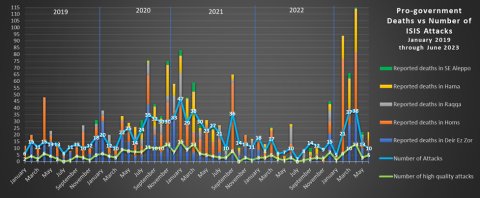
ISIS attacks dropped slightly in Deir Ez Zor (3) and Homs (3), while doubling in Hama (4). No incidents were documented in Raqqa (0) and Aleppo (0).
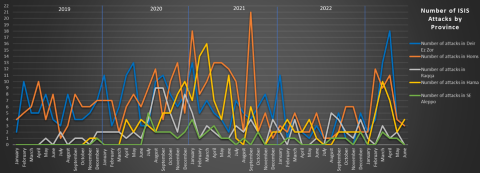
Deir Ez Zor and Raqqa
The number of ISIS attacks in Deir Ez Zor in April was unprecedented, more than at any point since the beginning of the insurgency in 2018. A dramatic reversal took place in May (4) and June (3). While most of the attacks in both months consisted of mines or IEDs—which would generally be considered a more passive style of attack—these incidents have begun more commonly occurring within Deir Ez Zor’s urban centers, rather than in the desert where ISIS enjoys more freedom of movement.
On June 11, a group of local pro-regime fighters were ambushed by ISIS while driving through Ain Ali, a suburb just outside the city of Mayadeen. Their vehicle was hit by an IED, after which they were attacked with small arms. Five men were killed, and one was reportedly captured by the attackers. On the same day, a mine or IED killed a soldier somewhere around the town of Boukamal.
On June 19, a convoy of the Iranian-backed Local Defense Forces (LDF) was hit by an IED while traveling through the town of Bogeleyah, just north of Deir Ez Zor city. The convoy included locals returning from training in LDF camps across Syria. The attack left five dead and seven wounded. It came just a few days after another IED was dismantled in the neighboring town of Shamitiyah.
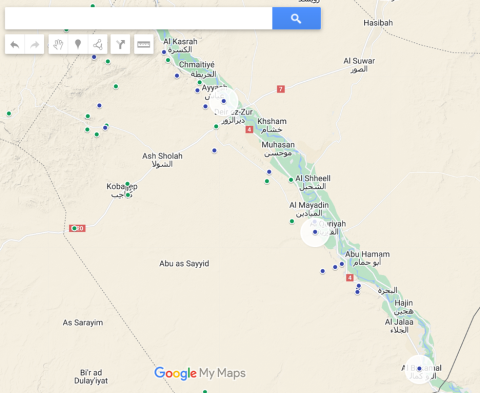
Map of locatable ISIS attacks in Dier Ez Zor (highlighted) in June 2023 alongside all other attacks in 2023.
Homs
April witnessed the end of the month-long regime offensive to secure al-Kawm, the strategic village in northeast Homs, but ISIS activity has continued in this region. In May, there were at least four ISIS attacks in the Sukhnah-Taybeh region, just south of Kawm, and at least two of June’s three recorded attacks also occurred in this area.
On June 6, two Liwa al-Quds fighters were reported missing while either patrolling or being stationed in the Easter Qasr Hariri area, which is east of Taybeh on the southern edge of the eastern Kawm mountains reportedly controlled by ISIS. The same day, four civilians harvesting wheat around Sukhnah were attacked by a group of militants. All four men were killed, and their harvester was destroyed.
On June 23, a brigadier general was reported killed somewhere in eastern Homs. It is not clear how or where he died exactly. However, many pro-regime reports stated that he was killed “in an ambush,” a phrase generally not used when someone is killed by a mine. He is the first general killed in the central Syria insurgency since November 2021.
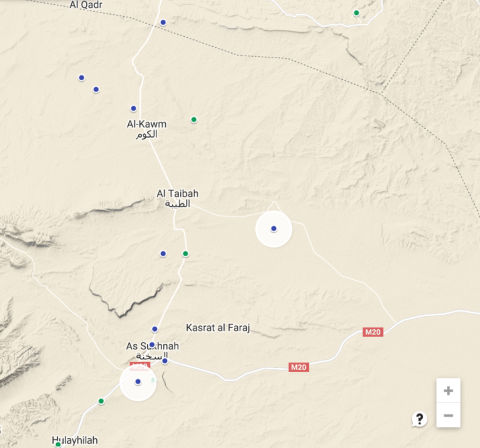
Map of locatable ISIS attacks in Homs and Raqqa (highlighted) in June 2023 alongside all other attacks in 2023. Not mapped is one attack that occurred somewhere in the Homs countryside.
Hama
ISIS activity doubled in June, with two of the four documented attacks emanating from official ISIS media. On June 7, a mine or IED killed one soldier and wounded a second near Tel Salima, northeast of Uqayribat and the site of a significant number of ISIS attacks earlier this year. On June 19, ISIS claimed to destroy a regime military truck with an IED east of Uqayribat, publishing a picture of the destroyed vehicle in their weekly Naba magazine. ISIS claimed a second attack in the same Naba edition, a mine or IED attack on another military truck west of Ithriya on June 22.
On June 25, a vehicle carrying Iranian-backed Liwa Imam al-Baqir fighters hit a mine or IED while driving along the Ithriyah-Sukhnah highway, leaving three dead and five wounded. This attack followed an attempt by ISIS militants to set up a fake checkpoint somewhere along the same highway on May 20.
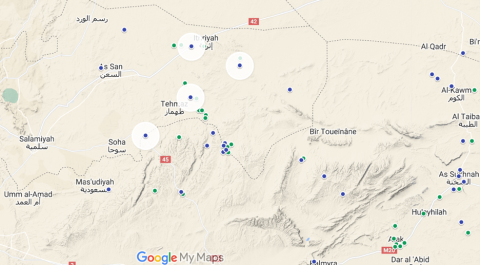
Map of locatable ISIS attacks in Hama and Aleppo in June 2023 (highlighted) alongside all other attacks in 2023.
Looking Ahead
The low number of overall attacks documented in June is not necessarily a sign of a weakening insurgency. The attacks themselves, while not as spectacular as those in 2020, are significant compared to those of recent years. ISIS not only published its first claims of central Syrian attacks in six months, it highlighted attacks in eastern Hama for the first time in exactly two years. This follows the return of ISIS small arms attacks in eastern Hama in February. Taken together, these shifts suggest a renewed focus on eastern Hama from ISIS cells and regional leadership (who would presumably be making the decision to publish media from these attacks). It should be remembered that this area was—and possibly still is—a key financial hub for the group.
The increase in IED and small arms attacks inside Deir Ez Zor’s urban belt are equally concerning. These urban areas in western Deir Ez Zor were long protected from ISIS attacks by a large security presence of various Syrian-, Russian-, and Iranian-backed armed groups. This author first highlighted the risk of ISIS infiltration into these areas via the new reconciliation process in December 2021. The first such urban attacks came a month later. It remains to be seen if ISIS cells will be able, or willing, to continue conducting these types of attacks in an area that is a key smuggling and transit route between regime and Syrian Democratic Forces’ controlled sides of the Euphrates River.
Lastly, Homs City itself saw two significant attacks in June (not recorded in this data as the city is not in the Badia). On June 13, a brigadier general was killed by an IED in a southwest neighborhood of Homs (separate from the brigadier killed 10 days later in eastern Homs), and on June 18 a transport truck was hit by an IED on the highway seven miles east of Homs, killing three and wounding seven. Neither attack was claimed by ISIS, yet both bear the hallmarks of the group’s ongoing IED attacks in southern Syria. As with May’s IED attack in central Damascus—which was claimed by ISIS—it is highly likely that the two Homs attacks were facilitated by militants and supplies from central Syria. This author has long highlighted ISIS’s apparent intention to re-enter Homs via the southern countryside around Maheen and Qaryatayn. As with all aspects of ISIS’s insurgency, the question is whether the regime has the capacity to quickly stamp out these possible new cells within the city.
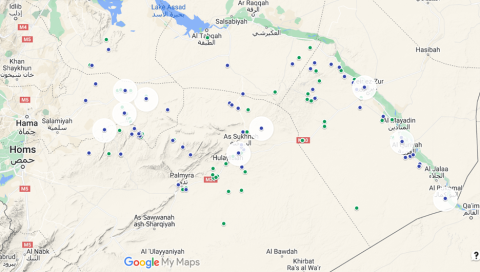
Map of locatable ISIS attacks (highlighted) in June 2023 alongside all other attacks in 2023. To view an interactive version of this map, please click here.
---
*High quality attacks are defined as attacks behind frontlines, those that result in seized positions, target regime officers, involve coordinated attacks on multiple positions, fake checkpoints, ambushes on military convoys, or attacks on checkpoints that kill at least three soldiers or lead to POWs.
Extremists: Their Words. Their Actions.
Fact:
On May 8, 2019, Taliban insurgents detonated an explosive-laden vehicle and then broke into American NGO Counterpart International’s offices in Kabul. At least seven people were killed and 24 were injured.
Get the latest news on extremism and counter-extremism delivered to your inbox.